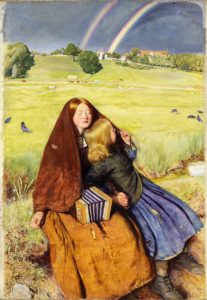In my deep dive into the connections between counterculture and Pre-Raphaelite painting, I partially focused on the use of natural motifs in both movements, namely flowers. With such an emphasis on floral elements, one British museum is staging an exhibition of Pre-Raphaelite works but looking at things from an unusual perspective. The exhibition highlights one of the senses rarely used in the traditional fine arts: scent and smell.
Starting on October 11th, Birmingham University’s Barber Institute of Fine Art will put on an exhibition called Scent & the Art of the Pre-Raphaelites. The show will explore the aromas evoked by the paintings and discuss how the Victorians perceived scent and smell. The exhibited paintings will include The Blind Girl by John Everett Millais and A Saint of the Eastern Church by Simeon Solomon, as well as works by Rossetti and Waterhouse on loan from the Ashmolean Museum and the Tate Britain. I initially thought the museum might pump the scents into the galleries where certain paintings are displayed. However, the Barber has gone for a different approach since that route may damage the pigments or canvas of the exhibited works. They plan on having small diffusers near the paintings, which individual museum-goers can approach and press a button to release the aroma. Smells of grass and flowers in a meadow following the rain will accompany the Millais. Meanwhile, aged wood and the aromatic oils from an incense burner would be the better choice for Solomon’s saint.
Olfactory technology is not new to museums. In 2022, Madrid’s Prado Museum enlisted the help of the Spanish perfume company Puig to develop a scent comprised of ten flowers, plants, and other elements from a large painting by Jan Brueghel the Elder. These included daffodils, iris, jasmine, orange blossom, rose, and the musk of a civet, the animal curled up near the nude female figure on the right side of the work. Several diffusers sat in the same room as the painting, where visitors would approach and interact with a touchscreen to experience just a small handful of the over eighty plant and flower species identified in the Brueghel painting. The aroma element of the display resulted in gallery visitors spending far longer viewing and interacting with the painting. Compared to the average of thirty-two seconds that a Prado visitor might spend looking at the Brueghel, adding the aroma diffusers increased that average to an incredible thirteen minutes.
The Barber Institute is also collaborating with Puig for its Scent & the Art of the Pre-Raphaelites exhibition, which will run from October 11th to January 26th.

